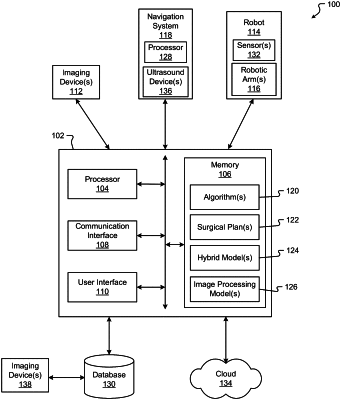| CPC A61B 34/20 (2016.02) [A61B 6/5247 (2013.01); G06T 11/60 (2013.01); A61B 2034/2063 (2016.02); G06T 2210/41 (2013.01)] | 18 Claims |

|
1. A system for generating a hybrid image comprising:
an imaging device;
a processor; and
a memory storing data for processing by the processor, the data, when processed, causing the processor to:
receive a preoperative image depicting at least one anatomical element;
receive a first intraoperative image from the imaging device depicting the at least one anatomical element;
input the preoperative image and the first intraoperative image into a hybrid model, the hybrid model configured to combine the first intraoperative image with the preoperative image;
generate, with an output of the hybrid model, a hybrid image comprising the preoperative image combined with the first intraoperative image;
receive pose information of the imaging device, the pose information correlating to one or more poses of the imaging device when the first intraoperative image was obtained;
generate a three-dimensional representation of the at least one anatomical element based on the preoperative image, the first intraoperative image, and the pose information, the three-dimensional representation including a pose of the at least one anatomical element;
receive a second intraoperative image;
detect movement in the at least one anatomical element based on a difference in the first intraoperative image and the second intraoperative image; and
update the pose of the at least one anatomical element in the three-dimensional representation when movement is detected in the at least one anatomical element.
|